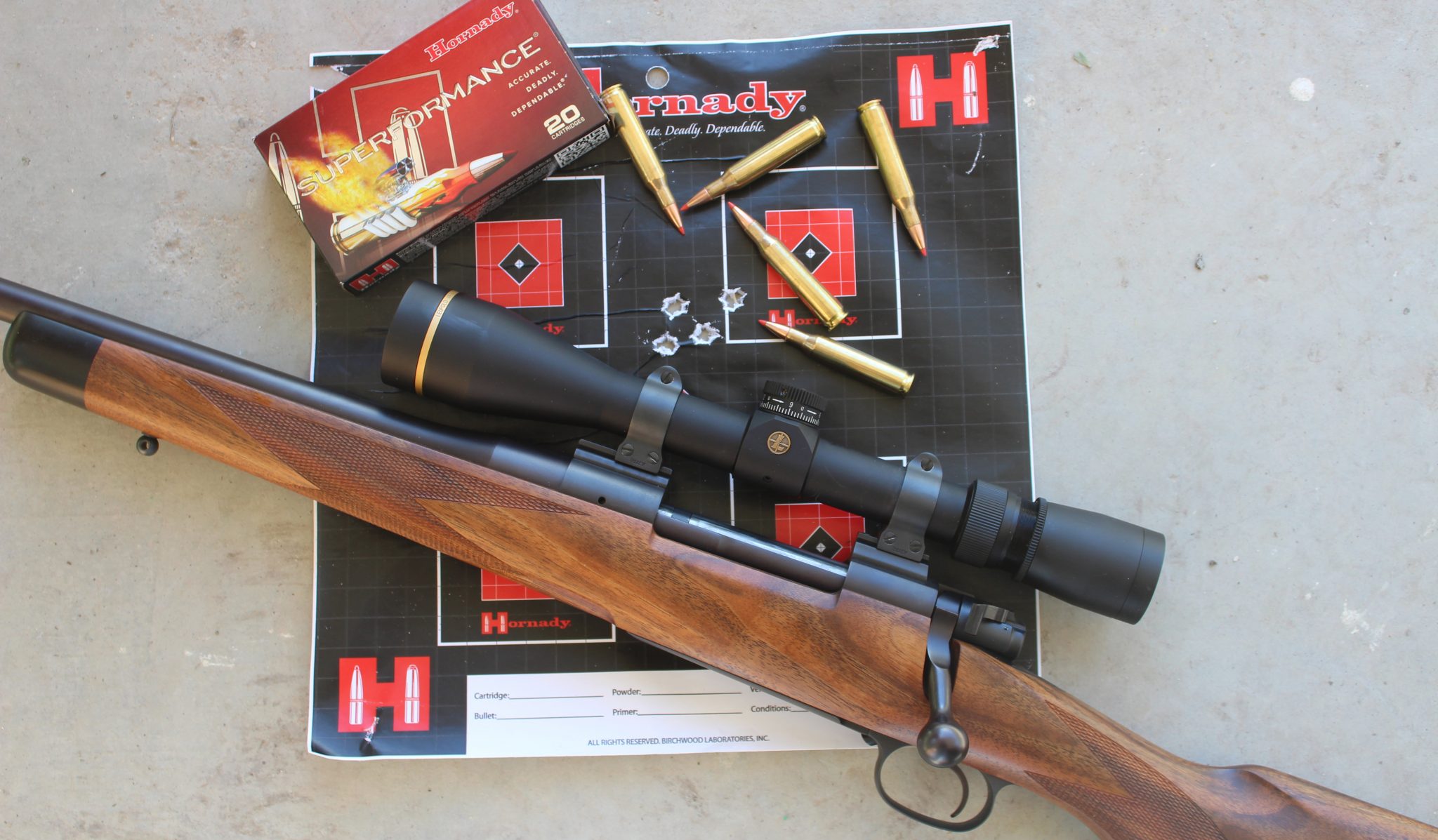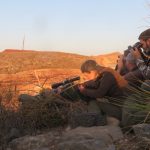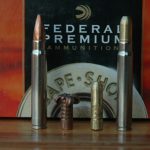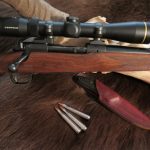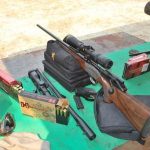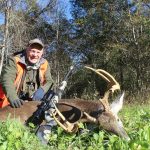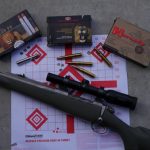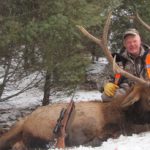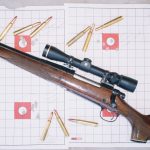But not too much!
Guys like me who are fascinated by hunting rifles and cartridges probably belabor the point. We agonize over the exact “perfect” choices when there are usually lots of suitable rifles and cartridges (and bullets and loads) that will work just fine for the job at hand. The old adage “beware the one-gun man” remains true…but if you’re a rifle nut settling on just one versatile and familiar choice would take away much of the fun, wouldn’t it? Also, I’d be out of a job as a gunwriter!
Fortunately for me there seems a near endless supply of rifles and cartridges to write (and argue) about, so our traditional campfire discussions over the “best” choices are in no jeopardy. But while we’re agonizing over the right rifle, cartridge, bullet, and load, are we giving enough thought to the most ideal sight or scope?
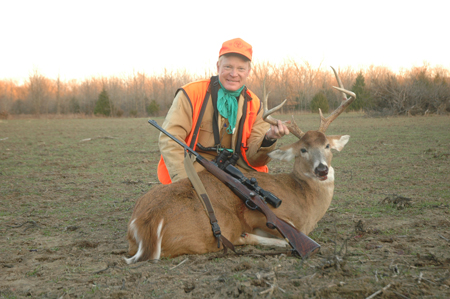
My favorite whitetail rifle is my Todd Ramirez 7×57…I’ve experimented with more powerful scopes, but it usually wears this Schmidt & Bender 1.5-6×44, clear and bright, and enough magnification for the country I use it in.
Recently my decisions got easier. There are certain specialized applications where iron sights, either open or aperture, may be superior to the magnifying riflescope. Unfortunately, I have reached the point where my eyes can no longer resolve iron sights well enough to be competent with them. I believe there are still situations where irons are sound options, but now I have to caveatthat with “if you can still see them!” I cannot, but there are other options; the non-magnifying reflex or red-dot sight offers a fast, accurate, and visible alternative to iron sights. There are also many close-range situations in which magnification isn’t necessary and may not be helpful. Again, the red-dot or reflex sight offers a marvelous alternative.
However, most hunters today are children of the scope era, so we probably think first of the magnifying riflescope. Although riflescopes saw effective use in the mid-19thCentury, they didn’t come into widespread use until after WWII. When I was a kid in that postwar era the “standard” hunting scopes—and my own first riflescopes—were fixed 4X. Larger scopes existed for varmints and target shooting, but variables hadn’t quite yet been perfected and were widely distrusted. Pundits of the day, certainly including Jack O’Connor, advised that, for big game hunting, there was no need for higher magnification than 4X. In the 1970s variable-power scopes came into common use, and in recent years scopes have just gotten bigger and bigger.
In an odd turn of fate several of today’s better-known gunwriters are almost exactly the same age: John Barsness, Ron Spomer, Wayne Van Zwoll, yours truly. Grumbling, as we become the curmudgeons we once abhorred, all of us have written that a fixed 4X is “enough scope” for most big-game hunting. Yes, it is, and many optics firms still offer a good old fixed 4X. I’m sure I have one or two around somewhere, but I can’t remember when I actually used a fixed 4X in the field!
I got my first 3-9X variable scope in about 1976, and I remember being enthralled by that hugemagnified image…and how much easier it made longer shots. I got spoiled, and I’m still spoiled. I like magnification! It reduces aiming error and allows for more precise shot placement. How much is enough depends on distance and size of target; more magnification can be used on small varmints than is needed for deer and elk!
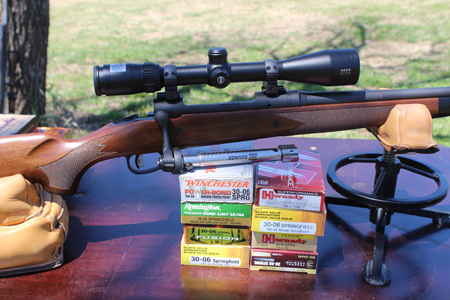
A Bushnell Elite 4500 scope in 1.5-10X, mounted on a left-hand Savage 110.30-06. The author believes a “medium-sized” variable scope in a similar power range is the most versatile, suited for a wide range of hunting purposes
On the other hand, there can be too much magnification. There are reasons for this. First, because of mirage and heat waves there are many situations where high magnification cannot be used. Prairie dog towns are bad for this, but in big-game hunting I’ve seen many situations where I couldn’t use magnification higher than about 15X. Second, on close shots too much magnification runs the risk of seeing just a blur of hair in the scope. The beauty of the variable-power scope is the highest magnification setting is there if you need it…but you aren’t obligated to turn the scope all the way up. It’s best to leave allvariables somewhere at a low to medium magnification until you want more power. If you can remember you aren’t required to use all the magnification at your disposal then there’s no harm in having it except it comes at two prices, one physical, the other literal. The larger the variable range the bigger and bulkier the scope! Why carry it if you don’t need it? Also, why pay for it if you don’t need it? Compared within the same product line, the higher the range of the variable the more expensive it will be.
Okay, as with choosing rifles and cartridges there are broad ranges of suitability, so it’s hard to make a “bad” choice. But some are better than others; it depends on the country and the game, but even then you never know exactlywhat kind of shot you might draw. For instance, last January I hunted Coues deer in northern Sonora. Few other hunts in the world are as optics-intensive, or as likely to result in a longish shot at a smallish animal. We were using Bushnell’s new Forge line; I put a 4.5-27x44mm scope on a Mossberg .300Winchester Magnum. Okay, so I was over-gunned and over-scoped, but the rifle was the new walnut-stocked Patriot Revere. At that moment caliber choices were limited. I went with the .300 and was ready for long shooting as needed. The scope, with that huge variable range, is obviously one of many scopes developed for the growing interest in extreme-range shooting. It was bright, and clear. It was also large and heavy, but I was set up for a worst-case long shot.
In the event it was clear, bright, and warm. Heat waves came up early, and there was no way to use all that magnification. When I shot my buck, we made a stalk and caught him in a pocket just over a little ridge, very close (as Coues deer go!). I don’t recall the setting, but I turned the scope ‘way down. Again, that’s the beauty of having higher magnification: You don’t have to use it unless you need it. So, the only real issues with the “big” variables currently in vogue is you have to pay for and carry capability you may not use.
That said, I’d rather have too much magnification available than not enough when I need it! Again, I started with fixed 4X scopes. I also had other fixed-power scopes from 2X to 3X. Call me spoiled, lazy, or just getting old, but today I want more magnification…and if I don’t, I’ll probably forget magnification altogether and slap on an Aimpoint!
Throughout most of my career America’s most popular scope has been the 3-9X variable. There’s no magic in that exact power range; you could throw 2.5-8X, 3.5-10X, and similar scopes into the same group. Again, I’m not an extreme-range shooter at game, so scopes in this class offer all the magnification I really need, including out to the longest distances I’m likely to shoot. Such scopes are usually of moderate bulk and weight…and, within any product line, are less costly than larger scopes.
These are the ranges of variables worn by most of my “general purpose” hunting rifles; I still find the good old 3-9X variable that I discovered forty years ago hard to beat. That said, I concede: Magnification is seductive, so on flatter-shooting rifles that might be used in big, open country I often take a step up. For years “three times zoom” was standard, but today five and six-times zoom (and more) is increasingly common, and this enhances capability without increasing weight and bulk. I have a couple of 2-12X (and similar) scopes, and my Jarrett .300 is wearing a Leupold VX6 in 3-18X. I haven’t needed to turn it all the way up in the field, but it’s a trim and fairly light scope and I don’t mind having its capability!
For sure, it’s better to have too much scope at your disposal than not enough! The biggest mistake we make, at least in my world, is our employment of the low-range “dangerous game” variables. Typically between 1-4X to 1.75-5X with a straight 24mm objective, these scopes are light and handy, ideal if you knowyour shot will be fairly close. If, for instance, you know you’re going to shoot a bear or a buffalo, your worst-case shot won’t be 200 yards, and you have plenty of scope.
This class of “dangerous game scope” is just fine for bears, boars, and buffaloes, and lots of other things I can think of). It is notfine for other uses one might have for the same rifle, often on the same trip. Your .375 (or .416) might be pressed into service for plains game, and you might see a wolf while bear hunting. The newer “dangerous game scopes” in 1-6X (or even 1-8X) offer more capability and versatility. These days, however, I often bypass this class of scope altogether. I’ve used a Leupold VXR 2-7x33mm on several .375s and .416s. Whether for dangerous game or plains game, this is enough magnification without adding much more weight and bulk, and the slightly larger objective adds light-gathering capability. Just now, on a forest hunt in Congo, using “camp rifles,” I had a choice between a Leupold 1-4x24mm or an Aimpoint. I used the Aimpoint for tracking in the forest, perfect…but when we sat in machansfor sitatunga and such I went with the magnifying scope. At the distance 4X was plenty, but scopes with straight objectives don’t gather much light; at dusk it was over quickly! A third option of a scope that gathered more light would have been welcome!
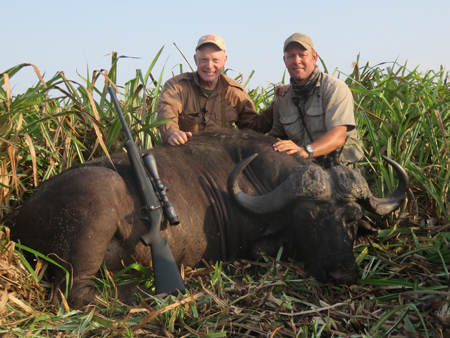
Although non-traditional, I used a Sig-Sauer 2.5-10X scope on a Blaser with .416 Remington Magnum barrel to take this buffalo. Although larger scopes add weight and bulk, one thing about having extra magnification is you don’t have to turn the scope up unless you need to.

